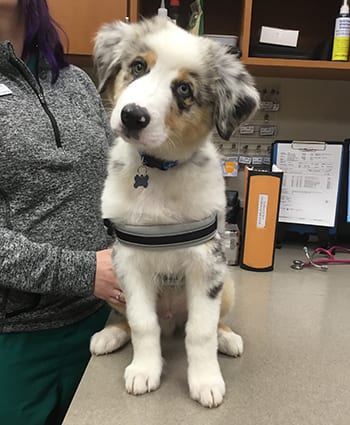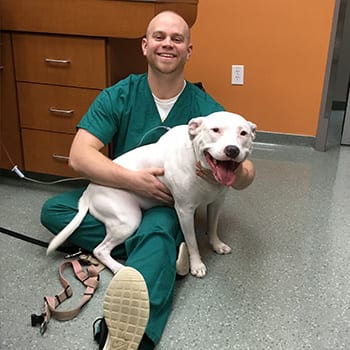NEW PUPPY PACK: WHAT TO EXPECT
The veterinarians at Melrose Animal Clinic are happy to help you make the best call for you and your pet.

*During your puppy's first visit we will also cover options for a microchip, flea, tick, and heartworm disease prevention, at-home dental care, spay/neutering, and insurance.
Physical examination: An important part of your pet's wellness. We will examine the eyes, ears, mouth, and teeth, as well as the coat, skin, and general muscular condition. We will feel the internal organs and listen to the heart and lungs. We will also weigh your pet and discuss with you its overall condition.
Fecal Examination: The fecal (stool) examination is a laboratory test that checks your pet for the presence of intestinal parasites, which is very common in puppies. These parasites can cause serious gastrointestinal upset resulting in vomiting and or diarrhea. They are also potentially contagious to humans.
Vaccinations:
- Core vaccinations include Rabies (once a year), DAP/Distemper/ Hepatitis/Parvovirus (given at 6-8 weeks of age, repeated every 3-4 weeks until 16 weeks of age).
- Lifestyle Vaccinations include Leptospirosis, Lyme CR and Canine Influenza (given in two doses, 3-4 weeks apart); as well as Bordetella (one dose of oral solution).
- For the full list of vaccinations for your puppy, visit our Vaccinations page.
SPAYING & NEUTERING
Our veterinarians recommend spaying female and neutering male puppies at the ages of 5-6 months of age. The doctor will discuss in detail the medical and behavioral benefits of the procedure for your pet.
Neutering: It reduces overpopulation, the spread of infectious diseases, and aggression toward other animals. It also eliminates the desire to seek out female dogs.
Spaying: Eliminates estrous (heat)-- no bloody discharge, ranting pacing/crying. Reduces risk for mammary cancer. Eliminates the risk of life-threatening infection of the uterus and decreases the desire to roam in search of a mate.
Crate/House Training Your Puppy
Crate training is an essential part of housebreaking. You will find that the crate is useful for having company over, car travel, and for ensuring that your puppy is safe at night. Think of the crate as a place your puppy can feel safe and secure, and he/she will respond positively to it.
Repeat the steps below a few times a day. After some time, your puppy will begin to feel at ease inside the crate and may even go into it on their own.

Make Training a Pleasant Experience
Tempt your puppy to enter the crate by placing a treat inside; be generous with your praises (if uncooperative, carefully place them inside). It is important to reassure throughout the process. Once your puppy is inside the crate for a few moments, call them to join you outside the crate and praise them when complete. Repeat the process with time increments and add in closing the door as they improve.
What if your puppy whines?
To get your puppy comfortable with staying in the crate quietly, place the puppy inside and slowly close the door. If they start to bark, say “no” in a commanding tone. Repetition will eventually lead to no whining when placed inside the crate. Gradually increase the time the puppy stays inside the crate. If they whine, wait for them to quiet down before letting them out again.
PUPPY SOCIALIZATION Q&A
Socialization is the process during which the puppy develops relationships with other living beings in its environment. While socialization takes place throughout the first year of life, the first 6-16 weeks seem to be the most important time for young puppies to learn about their environment.
- What is the best age to obtain my new puppy?
The puppy should remain with its mother and littermates until about 7 weeks of age, since it is critical for their development to interact, observe, and play with members of its own species. When placed in the new home, social contact can be expanded to new people and species while still in their primary socialization period. By this time, puppies will begin to develop preferences for elimination sites, so this is a good age at which to begin house training. See our handout on housetraining puppies.

TIPS:
*For new situations with the absence of treats, be sure to use a happy tone of voice and encourage your puppy.
*If your puppy seems to panic, back off a little and then try again later rather than aggravating the fear. Be sure to identify an emerging fear and work to revisit the situation slowly and gradually using rewards to turn the situation into one that is positive.
- What can I do to assist my puppy in its social development?
Introduce your puppy to as many new people/situations as possible, beginning in its first 3 months of development. One way to facilitate introductions is to provide a reward (a favorite toy or treat) with each new stimulus exposure. Once the puppy has learned to ‘sit’ on command, have new friends ask him to ‘sit’ before giving a treat. This teaches a proper greeting decreases the likelihood of jumping up on people.
- Is it healthy to take my puppy out in public at such a young age?
There is always a concern about the risks of taking puppies out of their home before being fully vaccinated as they may be exposed to viruses. A solution is to have people and healthy vaccinated animals visit the puppy in its own home until it is sufficiently vaccinated.
A compromise is to take the puppy out to meet new people/pets in a low-risk environment. As long as vaccines are up-to-date and you avoid neighborhood parks where stools and urine might accumulate, going out for walks along the sidewalk is safe.
You may consider enrolling the puppy in puppy socialization classes, too. If these classes are held indoors in a room that can be cleaned and disinfected, and all puppies are screened for vaccinations and health before each class, then these classes provide good exposure to people and other dogs.
TIPS FOR CLIPPING YOUR PET'S TOENAILS
Toenails are naturally curved. If they are not trimmed they can and will grow all the way around into the paw pad. An untrimmed dewclaw can easily get caught on something and cause injury.
*Your pet’s toenails are too long if they click on the floor!
*Sometimes with regular clipping, you will eventually cut a nail too short and the vein (quick) will bleed. Apply Kwik stop (you can purchase this at any pet store) into the bleeding nail until the bleeding subsides. You might have to apply this more than once.

Step-By-Step to Clip Nails:
Get your pet used to having all 4 paws handled. Spread the toes and gently pull on each nail. Familiarize him/her with the clippers by letting your pet sniff it, mouth it and gently rub it on their feet.
Look at and feel the underneath side of the nail. It will feel solid until you get close to the end-where you will then feel a hollow curved tip. The tip is past the quick and can be safely clipped off.
You must hold the paw steady, but holding too tightly will cause your pet to pull the paw away from you. Hold the paw between your first two fingers, place the third finger on the pad of one toe and press gently with your thumb on top. This will push the nail out and in a good position for clipping. Be careful with long-haired breeds and that fur does not get caught in the clipper. Clip quickly and at a slight angle away from you, just below where the nail curves/bends.
Common canine toxins to be aware of:
The following are the 10 categories of potentially deadly substances found in or near the home that are most frequently asked about by callers to the ASPCA center:
- Human medications and food (avoid garlic, grapes, onions, raisins, alcohol, xylitol)
- Insecticides, rodenticides, and gardening products
- Indoor and outdoor plants
- Veterinary medications (allergies)
- Household cleaners and chemical hazards
- Heavy metals
*Click here for emergency information. ASPCA Animal Poison Control 1-888-426-4435.
